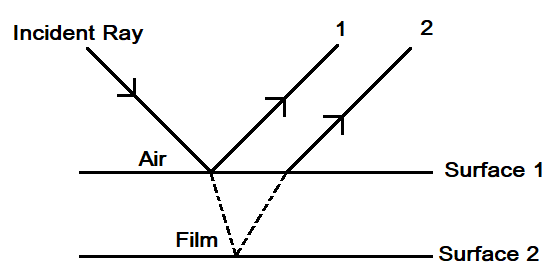Question
Question: A thin film of thickness t and index of refraction \[1.33\] coats a glass with index of refraction\[...
A thin film of thickness t and index of refraction 1.33 coats a glass with index of refraction1.50. What is the least thickness/that will strongly reflect light with wavelength 600 nm normal incidence?
Solution
The thin-film interference method or occurrence when a light wave is reflected off from the two surfaces with the surface separation is that of the wavelength distance. Due to this occurrence, the phase differences between the two surfaces are negligible when light passes from denser to rarer. Hence, the path difference for constructive interference of transmission of light is given as:
2μt=nλ
where μ is the refractive index, t is the thickness of the refractive surface, n is the refractive index, λ is the wavelength.
Complete step by step solution:
Let us draw the diagram to show how the light ray when traveling from rarer to denser medium refracts and from denser to rarer reflects from surface 1 to 2 and from 2 to 1.

Hence, there are two types of transmission of light i.e. constructive and destructive. For constructive transmission, the phase difference between the travelling of light is 180 degrees. The light from the incident ray is reflected and refracted from the first surface and second surface simultaneously. Hence, the minimum thickness for the transmission of light from surface 1 to surface 2 is:
2μt=nλ
Placing the value of λ, as λ=600nm, μ=1.33 and n=1.5 in the formula above:
t=2μnλ
t=2×1.331.5×600
=338.34nm
∴ The thickness of the glass for the transmission from surface 1 to surface 2 is 338.34nm.
Note: There are two constructive Interference for reflection and transmission are given as:
For constructive Interference for reflection is:
2(2n + 1) λ= 2μt
For constructive Interference for transmission is:
2μt=nλ
And the value of the wavelength transmission is λ and not 2λ due to higher refractive index.
